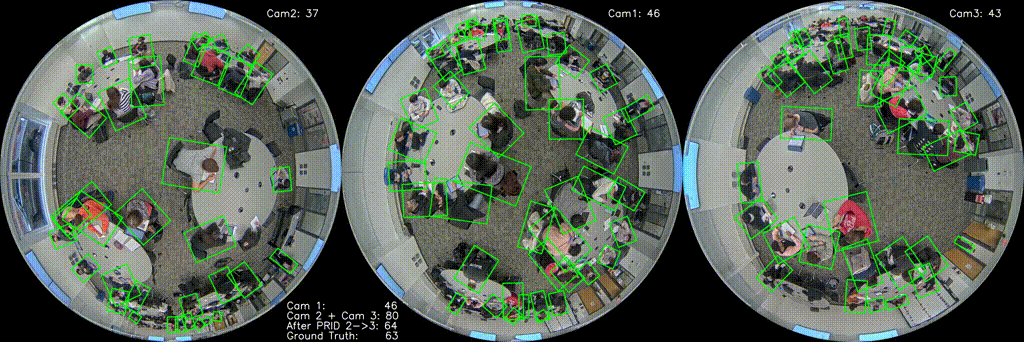Computational Occupancy Sensing System (COSSY)
MOTIVATION
Heating, ventilation, and air conditioning (HVAC) consume a significant portion of the energy used in commercial buildings. Much of this energy is wasted when buildings are occupied well below their maximum capacity. Traditional PIR (passive infrared) sensors, that detect movement, cannot estimate the number of people in a room. While CO2 sensors can provide a proxy measurement of occupancy level (inferred from CO2 concentration), their response to changes in occupancy is very slow due to air mixing. A new type of sensor system is needed to enable advanced HVAC control. Deployed in commercial buildings, such sensor systems have the potential for a significant reduction in energy consumption and the associated reduction of CO2 emissions.
PROJECT INNOVATION
The Computational Occupancy Sensing SYstem (COSSY) estimates the number of people and monitors how this number changes over time. The proposed system is designed to deliver robust performance by combining data from thermal door sensors and overhead fisheye cameras. Data streams from the sensors and cameras undergo advanced processing to jointly provide an accurate occupancy estimate. All the processing is performed locally within a building’s infrastructure (no processing in the cloud) to mitigate security concerns. The system features a modular design to accommodate various room sizes and geometries.
PROJECT TEAM
- Faculty: J. Konrad, P. Ishwar, T. Little, M. Gevelber
- Lead researcher and system developer: M. Cokbas (ENG, PhD’24)
- Graduate researchers: O. Tezcan (ENG, PhD’22), Z. Duan (ENG, MS’20), S. Li (ENG, MS’19)
- Undergraduate researchers: J. Zolkos (ENG, BS’24), V. Pyltsov (ENG, BS’23), J. Bolognino (CAS, BS’23), Z. Lu (ENG, BS’22), J. Bone (ENG, BS’21), G. Sorescu (ENG, BS’22), R. Verdile (ENG, BS’21)
PROJECT PROGRESS
The project has been completed and currently is in the commercialization phase. For a detailed description of completed COSSY research and resulting datasets, please follow the links below:
- Occupancy sensing using overhead fisheye cameras
- Occupancy sensing using thermal door sensors
- Occupancy sensing using CO2 sensors (versus fisheye cameras)
- COSSY datasets
SYSTEM ARCHITECTURE AND TESTING
COSSY uses standard fisheye cameras, PoE networking, and commodity computing hardware to deliver accurate people counts. Its computational engine uses AI algorithms developed at Boston University with funding from ARPA-E and is supported on both CPUs and GPUs. COSSY output supports both analog and digital interface to building managements systems. A COSSY version using Axis M3057-PLVE fisheye cameras and Intel NUC (I7, 32 GB RAM) had undergone extensive in-house testing at Boston University and, as mandated by ARPA-E, by a third party testing (Michigan State University). The video below shows one test result (“Cam1” shows people count from the middle camera, “Cam2+Cam3” shows the sum of counts from two side cameras, “After PRID 2->3” shows the count established by removing double-counts using person re-identification). Over multiple days, with occupancy as high as 87, a two-camera COSSY produces counts within 5 off the ground truth 92% of times. For a detailed analysis of COSSY performance in single-camera and multi-camera configurations please see this paper:
J. Konrad, M. Cokbas, P. Ishwar, T.D.C.Little, and M. Gevelber, “High-accuracy people counting in large spaces using overhead fisheye cameras,” Energy Build., vol. 307, p. 113936, Mar. 2024.
POTENTIAL IMPACT
This project is expected to help reduce the amount of energy (by up to 30%) needed to effectively heat, cool, and ventilate commercial buildings without sacrificing occupant comfort or privacy, but also has potential for other applications.
- Economy: Buildings will require less energy to operate, reducing HVAC costs for businesses. In addition, better controlled ventilation may lead to improved indoor air quality and increased worker productivity. Also, learning occupancy patterns over time, COSSY can help optimize space usage in office buildings, commercial spaces, etc. by means of the so-called spatial analytics.
- Security and Safety: Lower electricity consumption by buildings eases strain on the grid, helping to improve resilience and reduce demand during peak hours, when the threat of blackouts is greatest. Also, knowing the number and location of people in a building is key for emergency response in fire, chemical-hazard, actives-shooter, etc. scenarios.
- Environment: Using significantly less energy could help reduce emissions attributed to power generation. In addition, improved interior air quality could help prevent negative effects on human health.
